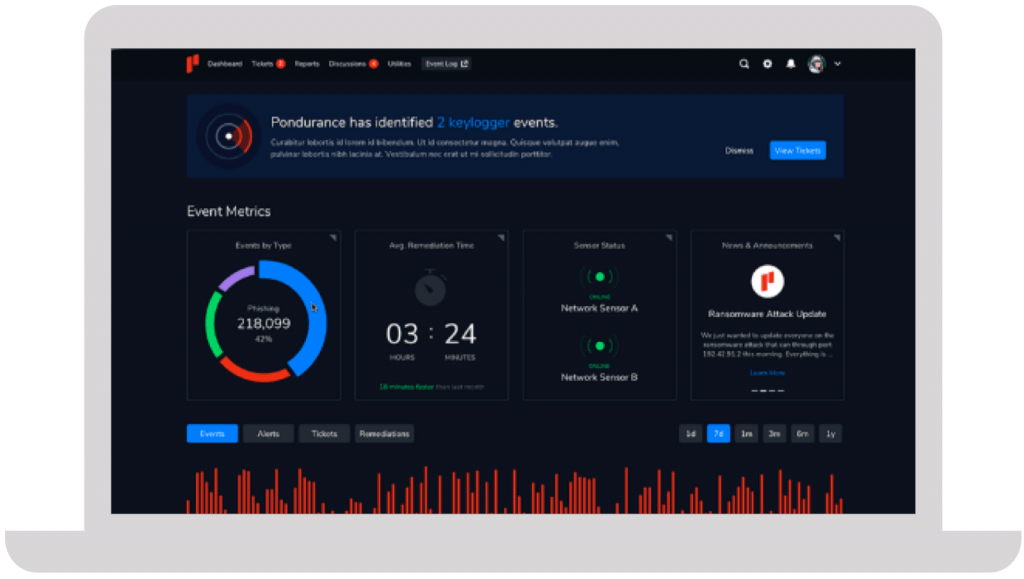

Shortage of cybersecurity talent
Security professionals are expensive and hard to retain
New compliance and regulation requirements
Undocumented processes in the event of an attack or breach
Security technology is expensive and hard to maintain
Technology alone can't deter motivated attackers
Lack of visibility across the enterprise
Difficulty managing multiple tools and investigating all alerts

We take a personalized approach to developing your cybersecurity program. Instead of an all-or-nothing approach like other MDR providers, Pondurance lets you pay for what you need, without sacrificing the visibility and transparency you want.
The number of data breaches continues to escalate, putting small businesses on high alert. Nowadays, any information that a business finds valuable is monetizable and a potential target for attack. Learn more in our eBook.
Your company has its own unique set of cyber risks. Though you can’t control the evolving cyber landscape, you can control your cybersecurity strategy. But what’s the best strategic approach to cybersecurity today? Learn more in our eBook.
Join us on-demand to discuss components of MDR and how to choose the right provider for your organization.







They immediately proved their value and earned our trust due to their immense expertise and guidance throughout the entire process.
Steve Long, CEO @ Hancock Health
Risk-based cybersecurity is a strategic approach to protecting an organization’s digital assets by focusing on identifying, assessing, and mitigating the most critical cyber threats and vulnerabilities. Unlike the traditional maturity-based model of cybersecurity risk management, which focuses on achieving specific levels of security controls, risk-based cybersecurity prioritizes resources and investments based on the level of risk posed to the organization. This enables businesses to allocate their efforts more efficiently and concentrate on protecting what matters most in their unique environment.
One key benefit of adopting a risk-based approach to cybersecurity is that it allows organizations to develop customized controls for critical vulnerabilities. This means that instead of implementing generic security measures without considering their relevance or effectiveness in addressing specific threats, organizations can tailor their defenses according to the unique risks they face. By doing so, businesses can ensure that they are focusing on what’s most important to protect, leading to improved overall security posture and resilience against cyber-attacks.
Pondurance’s risk-based approach provides customized cybersecurity solutions that align with specific customer business goals and desired business outcomes. By taking into consideration factors such as industry sector, threat landscape, regulatory requirements, organizational culture, and existing infrastructure, Pondurance ensures that its services are tailored to meet each client’s unique needs. This bespoke approach ensures that every organization receives a personalized roadmap for improving their cybersecurity defenses while minimizing disruption and maintaining optimal operations.
Moreover, a risk-based approach to cybersecurity also promotes proactive prevention rather than reactive response. By continuously monitoring and analyzing potential threats in real-time, organizations can stay ahead of cybercriminals and adapt their defenses before an attack occurs. This level of agility is crucial given the ever-evolving nature of cyber threats today.
In conclusion, adopting a risk-based approach to cybersecurity shifts the focus from simply meeting standardized compliance requirements towards addressing the specific risks faced by each organization. By leveraging customized controls for critical vulnerabilities and aligning with individual business goals and desired outcomes, Pondurance’s risk-based cybersecurity services ensure that organizations can effectively protect their most valuable assets while maintaining operational efficiency. With the continuously changing cyber threat landscape, it is essential for businesses to adopt a strategy that prioritizes and mitigates the risks that matter most to their organization.
Informed security teams must remain vigilant against evolving cybersecurity threats. By leveraging threat intelligence and conducting regular cyber threat assessments, organizations can stay one step ahead of potential adversaries and proactively strengthen their security posture. Additionally, implementing a robust cyber risk management strategy that includes vulnerability management and continuous monitoring of information systems is essential for mitigating potential threats and minimizing the risk of data breaches. By prioritizing cybersecurity and adopting proactive measures, businesses can effectively reduce their exposure to cyber risks and safeguard their sensitive data from unauthorized access or exploitation.
A risk-based cybersecurity framework and guidelines serve as a crucial cornerstone for organizations striving to protect their digital assets and maintain the integrity of their operations. By adopting a risk-based approach to cybersecurity, businesses can prioritize resources, establish clear objectives, and implement effective controls that address the most significant threats.
One of the essential components of this approach is conducting regular cybersecurity risk assessments. These assessments help organizations identify potential vulnerabilities in their information systems, evaluate the impact of cyber threats on business operations, and deploy appropriate mitigation strategies. Furthermore, these assessments provide valuable insights into an organization’s security posture and enable continuous improvement through iterative processes.
Another key feature of a risk-based cybersecurity framework is its alignment with recognized industry standards such as the National Institute of Standards and Technology (NIST) risk management framework. Adhering to such guidelines ensures that an organization’s security practices are in line with best practices and regulatory requirements while providing additional credibility within the industry.
In today’s rapidly evolving threat landscape, it is vital for companies to focus their cybersecurity efforts on areas posing the highest risks. To achieve this goal, organizations must adopt a proactive stance by leveraging advanced analytics tools and methodologies that enable them to prioritize threats based on their potential impact on business objectives.
Pondurance recognizes the importance of adopting a risk-based approach to cybersecurity and offers consultative services designed to help organizations implement comprehensive security programs tailored to their unique needs. Through ongoing risk assessment solutions, Pondurance enables businesses to continually refine their security posture in response to emerging cyber risks while ensuring that critical resources are directed towards addressing high-priority vulnerabilities.
In conclusion, implementing a risk-based cybersecurity framework and guidelines empowers organizations to optimize resource allocation, enhance threat detection capabilities, and improve overall security effectiveness. By partnering with experienced providers like Pondurance that specialize in consultative services and ongoing risk assessment solutions, businesses can build robust security programs designed to withstand even the most sophisticated cyber attacks while maintaining focus on core business objectives.
A risk-based approach to cybersecurity is a strategic method that focuses on identifying, assessing, and addressing the most significant threats and vulnerabilities faced by an organization. This approach enables businesses to prioritize their resources effectively, ensuring that they are well-equipped to protect their most valuable assets from potential cyber attacks. By adopting a risk-based strategy, organizations can significantly enhance their overall security posture while optimizing their operational efficiency.
One of the key components in implementing a risk-based cybersecurity strategy is leveraging the expertise of an outsourced Security Operations Center (SOC). An SOC serves as the central hub for monitoring, detecting, and responding to security incidents in real-time. It provides continuous analysis of an organization’s digital environment, using state-of-the-art technology and skilled professionals who specialize in various aspects of cybersecurity.
The primary advantage of outsourcing a SOC within a risk-based approach lies in its ability to provide tailored services that cater specifically to each client’s unique requirements and threat landscape. Through operational risk management cyber security measures, SOCs can identify and prioritize risks according to their potential impact on a client’s business operations. Consequently, this allows for more effective allocation of resources towards addressing those risks deemed most significant.
At Pondurance Security Operations Centers, experienced analysts work side-by-side with digital forensics specialists and threat hunters to deliver comprehensive end-to-end services that align with clients’ specific priorities. This collaborative effort ensures that clients receive personalized support designed to safeguard their most critical assets while advancing their desired business outcomes.
The Pondurance SOC further bolster this approach by actively monitoring global threat intelligence feeds and staying up-to-date with emerging trends in cybercrime. This knowledge enables them to proactively adapt their defensive strategies and better protect clients against evolving threats. Moreover, it also helps streamline incident response procedures, minimizing potential damage caused by security breaches.
In addition to delivering customized solutions based on individual needs, other essential steps within a risk-based approach include conducting regular assessments of organizational policies and procedures; implementing robust technical controls; and ensuring that staff are fully trained in security best practices. By following these risk-based approach steps, businesses can significantly reduce their exposure to cyber threats while maximizing the return on investment in their cybersecurity programs.
In conclusion, a risk-based approach to cybersecurity offers organizations a strategic, tailored, and efficient way of protecting their most valuable assets against potential cyber attacks. Outsourcing a Security Operations Center not only enhances an organization’s ability to implement this approach effectively but also provides the much-needed expertise and technology necessary for staying ahead of the ever-evolving threat landscape.
In today’s ever-evolving cyber landscape, organizations need to adopt a proactive and comprehensive approach to safeguard their critical assets from potential threats. A risk-based cybersecurity approach can offer numerous benefits that help organizations identify, prioritize, and mitigate risks effectively. This approach is centered around understanding the organization’s risk appetite thresholds and implementing appropriate controls for vulnerabilities.
One of the key benefits of a risk-based cybersecurity approach is its focus on risk reduction. By prioritizing resources and investments based on identified risks, organizations can ensure their cybersecurity programs deliver tangible business value and a higher return on investment (ROI). This in turn allows them to allocate resources optimally, aligning their security posture with their strategic objectives.
Moreover, having a proactive cybersecurity strategy enhances an organization’s cyber resilience. This means they are better prepared to anticipate, withstand, recover from, and adapt to adverse cyber events or disruptions. Reducing enterprise risk is essential in maintaining a strong reputation in the market and ensuring continuity of operations in the face of evolving threats.
A consultative partner like Pondurance takes this concept further by bundling services tailored to clients’ desired business outcomes. This holistic approach addresses gaps that standalone tools or services may leave unaddressed. By working closely with clients and understanding their specific needs, Pondurance develops tailored solutions that support business goals while providing end-to-end cybersecurity offerings.
In conclusion, adopting a risk-based cybersecurity approach offers substantial benefits such as effective risk reduction, enhanced cyber resilience, reduced enterprise risk exposure, and improved alignment with business goals. Partnering with an experienced provider like Pondurance ensures organizations have a journey partner who takes a consultative approach to delivering robust cybersecurity solutions customized to meet their unique needs.
4 Core Categories Of A Risk-Based Approach
A risk-based approach is a strategic process employed by organizations to identify, assess, and mitigate potential risks in their operations. This methodology prioritizes resources and efforts based on the potential impact of each risk, ensuring that the most significant threats are addressed first. The four core categories of a risk-based approach include identification, assessment, management, and monitoring.
To implement a successful risk-based approach, one must first identify the potential risks that an organization may face. For instance, when evaluating an individual’s cybersecurity threat level, factors such as access privileges, job function, technology usage patterns, and previous security incidents should be taken into consideration. This step involves gathering data from various sources to develop a comprehensive understanding of potential vulnerabilities.
Following the identification process is risk assessment. In this stage, organizations analyze the identified risks to determine their likelihood of occurrence and potential impact. Cyber risk quantification techniques can be employed to measure and prioritize these risks accurately. By quantifying cyber risks, organizations can make informed decisions about where to allocate resources for maximum effect.
Risk management focuses on developing strategies to mitigate or eliminate identified hazards. These strategies may involve implementing new processes or technologies or adjusting existing ones. Examples of risk management solutions include enhancing access controls, conducting employee training sessions on cybersecurity best practices, and updating software systems regularly.
Lastly, monitoring ensures that risk management measures are effectively reducing risks over time. Continuous monitoring allows organizations to track changes in their risk landscape and adjust their mitigation strategies accordingly.
In summary, adopting a risk-based approach enables organizations to proactively address evolving threats while optimizing resource allocation for maximum results. By incorporating identification, assessment (risk-based approach example), management (risk-based approach steps), and monitoring into their security strategy (risk-based approach which factors should be taken into consideration when evaluating an individual), businesses can stay ahead of cyber threats while maintaining operational efficiency. Moreover, leveraging cyber risk quantification techniques will only enhance this effectiveness by providing valuable metrics for decision-making and prioritization.